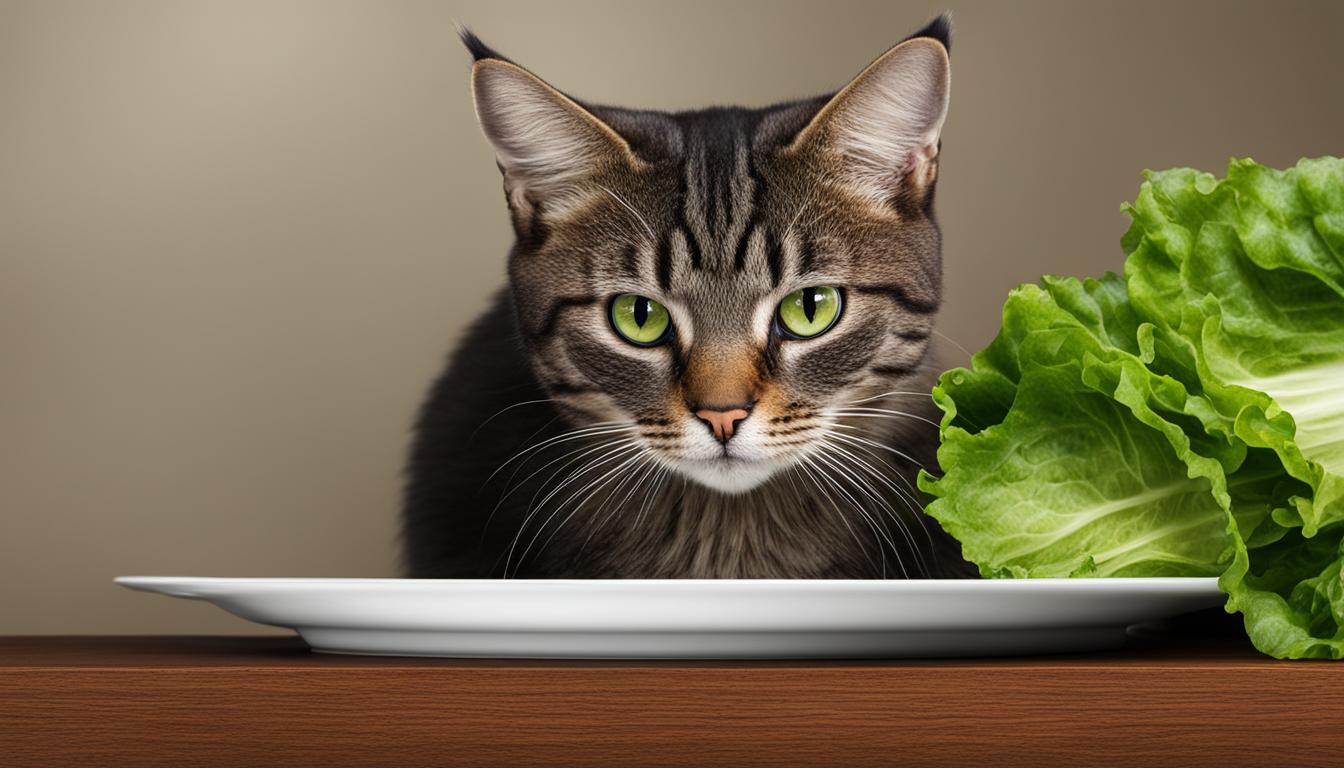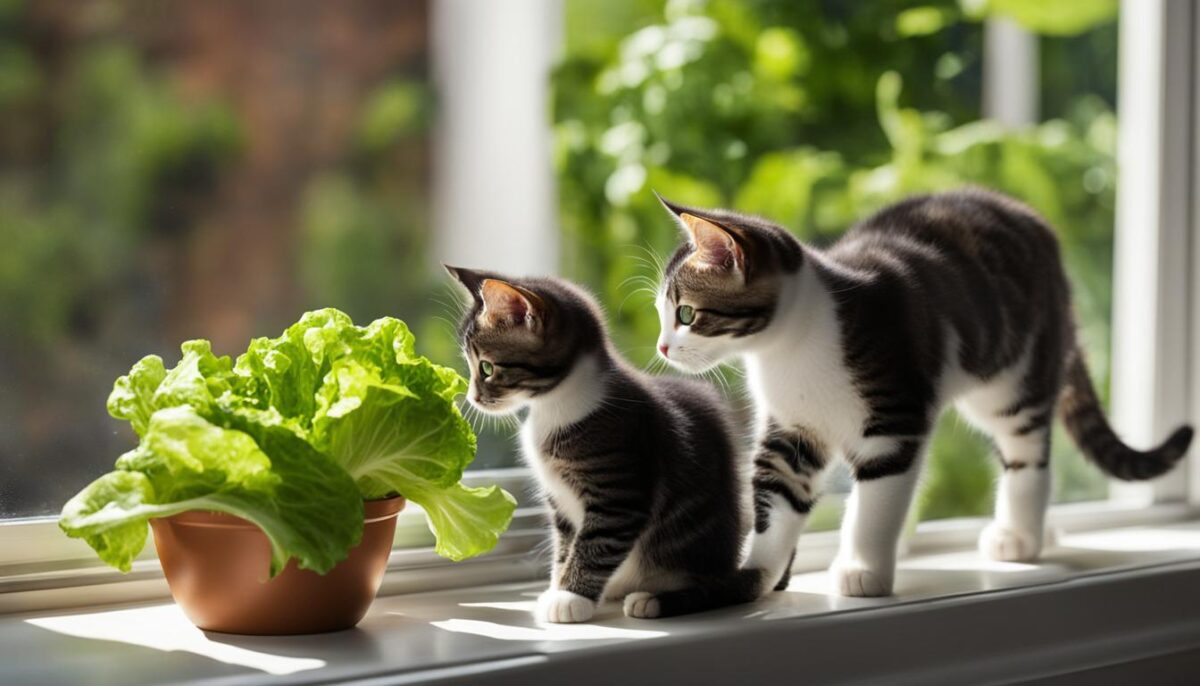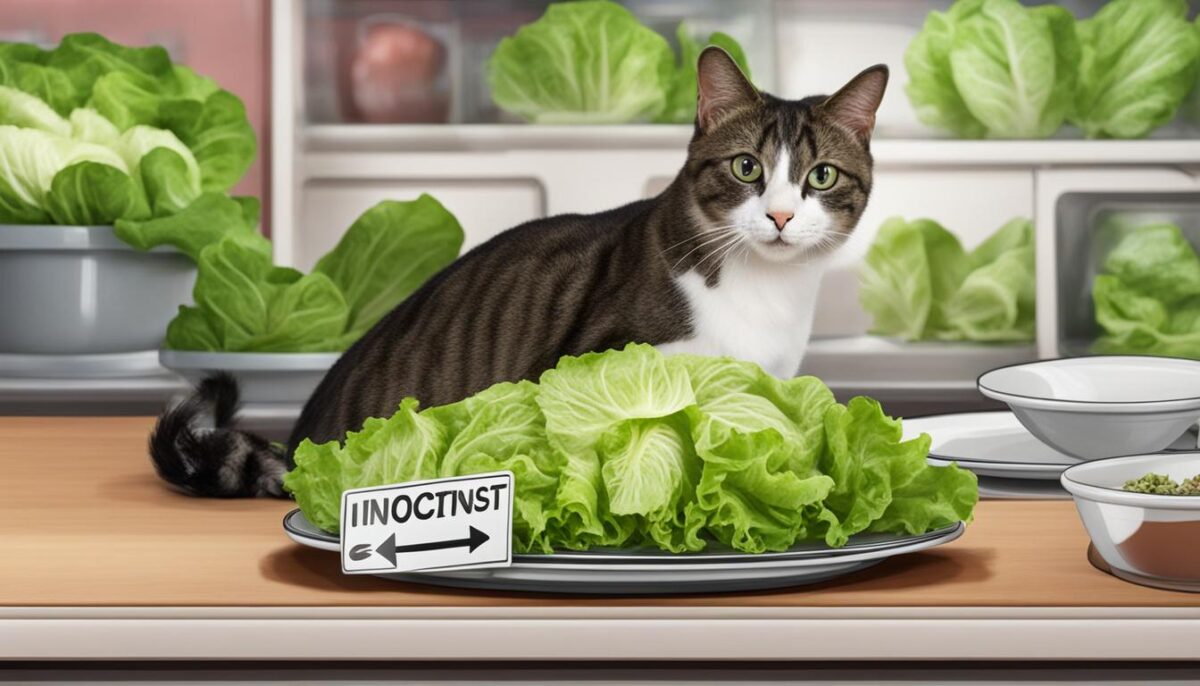Are you curious about whether cats can eat lettuce? Many pet owners wonder if it’s safe to share this leafy green with their feline friends. Let’s explore the topic and find out if lettuce is a suitable addition to your cat’s diet.
Key Takeaways:
- Lettuce can be safe for cats to eat in moderation.
- It can provide hydration, fiber, and some essential vitamins and minerals.
- Cats should not rely on lettuce as their main source of nutrition.
- Always consult with a veterinarian before introducing any new food to your cat’s diet.
The Benefits of Lettuce for Cats
When it comes to incorporating vegetables into your cat’s diet, lettuce can be a cat-friendly option. This leafy green provides several benefits for your feline friend. Lettuce is not only safe for cats to eat, but it can also offer some nutritional value.
One of the main benefits of lettuce for cats is its high water content. Since cats can be prone to dehydration, especially if they consume a dry food diet, offering them lettuce can help increase their water intake. Lettuce can be a refreshing and hydrating snack for your cat.
In addition to hydration, lettuce also contains fiber, which aids in digestion and helps regulate bowel movements. Including some lettuce in your cat’s diet can prevent constipation and promote a healthy digestive system.
“Lettuce can be a refreshing and hydrating snack for your cat.”
Lettuce is also a source of essential vitamins and minerals that are beneficial to your cat’s overall health. It contains vitamin C, which helps support the immune system, vitamin K, which contributes to blood clotting, and potassium, which is important for muscle function.
| Nutrient | Amount per 100g of Lettuce |
|---|---|
| Vitamin C | 13.7 mg |
| Vitamin K | 126.3 mcg |
| Potassium | 194 mg |
Overall, lettuce can be a great addition to your cat’s diet as long as it is given in moderation. It is important to remember that cats are obligate carnivores and should primarily consume a meat-based diet. Lettuce should not replace the main source of nutrition for your feline friend.
Remember to always consult with your veterinarian before introducing any new food into your cat’s diet, including lettuce. They can provide personalized advice and guidance based on your cat’s specific needs and health conditions.
Feeding Lettuce to Your Cat
Feeding lettuce to your cat can be a healthy addition to their diet when done correctly. Follow these tips to ensure your cat enjoys lettuce safely and in moderation.
Preparing Lettuce for Your Cat
Before offering lettuce to your cat, it’s important to wash it thoroughly to remove any dirt or pesticides. Cut the lettuce into small, bite-sized pieces to prevent choking and make it easier for your cat to eat. Offering one or two leaves as a treat or mixing it into their main meal is a good way to introduce lettuce to their diet.
Moderation is Key
While lettuce can provide some hydration and additional fiber for your cat, it should not be the sole ingredient in their food bowl. Cats are obligate carnivores, and their diet should primarily consist of meat. Lettuce should be offered as a supplement or occasional treat in moderate amounts to avoid nutrient imbalances.
Observing Your Cat’s Preference
Not all cats are interested in eating lettuce, and that’s perfectly fine. Each cat has their own taste preferences, and it’s important to respect them. If your cat shows no interest in lettuce, there’s no need to force them to eat it. There are other leafy greens that cats can safely eat, so you can try offering different options to see if they prefer something else.
Remember, it’s always best to consult with a veterinarian before making any significant changes to your cat’s diet. They can provide personalized recommendations based on your cat’s specific needs and health condition. By introducing lettuce in moderation and paying attention to your cat’s preferences, you can safely incorporate this leafy green into their diet.
| Lettuce Benefits for Cats | Cautions |
|---|---|
|
|
Cats’ Preference for Lettuce
While some cats may enjoy the taste of lettuce and find it refreshing, not all felines have an interest in eating this leafy green. Cats are known for their discerning palates, and their preferences can vary greatly. Just as some humans may love certain foods while others dislike them, cats too have their own individual tastes.
It’s important to remember that cats are obligate carnivores, meaning their bodies are designed to primarily thrive on a meat-based diet. While lettuce can provide some hydration and essential nutrients, it should not be the main component of a cat’s diet. Therefore, if your furry friend shows no interest in lettuce, there’s no need to be concerned.
If you’re curious about introducing lettuce to your cat’s diet, it’s best to start with small amounts as a treat or mix it into their regular food. Observe their response and ensure they don’t develop any adverse reactions. If your cat continues to show disinterest, there’s a wide array of other cat-friendly vegetables you can explore to provide variety in their diet.
The Importance of Respect
“Just as with humans, cats have their own unique tastes and preferences. It’s crucial to respect their individual choices when it comes to food.”
As a responsible cat owner, it’s vital to respect your feline companion’s preferences and not force them to eat lettuce if they don’t enjoy it. Just as with humans, cats have their own unique tastes and preferences. It’s crucial to respect their individual choices when it comes to food.
While some cats may happily gobble up a leaf of lettuce, others may turn their noses up at it. As long as your cat has a balanced and nutritious diet that meets their specific dietary needs, their preference for lettuce or lack thereof shouldn’t be a cause for concern. Remember to consult with your veterinarian for guidance on providing a suitable diet for your furry companion.
Safety and Risks of Feeding Cats Lettuce
Lettuce is generally considered safe for cats to eat, but there are important factors to consider when feeding it to your feline friend. While lettuce can provide some hydration and nutrients, it should only be given to cats in moderation. Feeding too much lettuce can disrupt the balance of nutrients in their diet, as cats require primarily meat for their nutrition.
It’s crucial to note that although lettuce is safe for cats, it should never be the sole ingredient in their food bowl. Their diet should be primarily composed of meat to ensure optimal nutrition. Lettuce can be offered as a treat or added in small amounts to their main meal. However, it’s essential to wash lettuce thoroughly to remove any pesticides or chemicals that could be harmful to cats.
Cats have unique dietary needs as obligate carnivores, which means they require a diet rich in animal protein to meet their nutritional requirements. While lettuce can provide some benefits, such as hydration and fiber, it should not replace the essential nutrients found in meat-based diets. Always consult with a veterinarian before introducing any new food into your cat’s diet to ensure their nutritional needs are met.
Table: Pros and Cons of Feeding Cats Lettuce
| Pros | Cons |
|---|---|
| Lettuce provides hydration. | Feeding too much lettuce can disrupt the balance of nutrients in a cat’s diet. |
| Lettuce contains fiber. | It should not be the main component of a cat’s diet. |
| Lettuce can be a low-calorie option for overweight cats. | Cats require primarily meat for optimal nutrition. |
| Lettuce may help deter cats from eating other plants in the house. | Thoroughly wash lettuce to remove any harmful pesticides or chemicals. |
In summary, while lettuce is safe for cats to eat, it should only be given in moderation as part of a balanced diet. It can provide some hydration, fiber, and other nutrients, but it should not replace meat as the primary source of nutrition. Always consult with a veterinarian before making any significant changes to your cat’s diet.
Other Leafy Greens for Cats
In addition to lettuce, there are other types of leafy greens that cats can safely enjoy as part of their diet. These cat-friendly vegetables provide a variety of nutrients and flavors that can be a tasty addition to your cat’s meals.
1. Spinach
Spinach is a nutritious leafy green that can be beneficial for cats. It is rich in vitamins A, C, and K, as well as iron and calcium. However, it’s important to feed spinach in moderation, as high levels of oxalic acid found in spinach can interfere with calcium absorption.
2. Kale
Kale is another leafy green that can be included in your cat’s diet. It is packed with vitamins A, C, and K, as well as fiber and antioxidants. However, kale should be steamed or cooked before serving to make it easier for your cat to digest.
3. Swiss chard
Swiss chard is a colorful leafy green that cats can enjoy in small amounts. It contains vitamins A, C, and K, as well as magnesium and potassium. Like kale, Swiss chard should be cooked before offering it to your cat to aid in digestion.
Remember, when introducing any new food to your cat, it’s important to start with small amounts and monitor their reaction. Some cats may have allergies or sensitivities to certain vegetables, so it’s always best to consult with your veterinarian before making any significant changes to your cat’s diet.
Table: Nutritional Comparison of Leafy Greens
| Leafy Green | Vitamin A | Vitamin C | Vitamin K | Iron | Calcium |
|---|---|---|---|---|---|
| Lettuce | Low | Low | Low | Low | Low |
| Spinach | High | High | High | Moderate | Moderate |
| Kale | High | High | High | Moderate | Low |
| Swiss chard | High | High | High | Moderate | Low |
As shown in the table, while lettuce may be low in certain nutrients, other leafy greens like spinach, kale, and Swiss chard offer higher levels of vitamins and minerals that can be beneficial for your cat’s overall health. Remember to always introduce new foods gradually and consult with your veterinarian for specific dietary recommendations for your cat.
Lettuce in Commercial Cat Food
When it comes to commercial cat food, lettuce is not a commonly used ingredient. This is because cat food is primarily focused on providing the necessary nutrients from meat sources, which are essential for a cat’s diet. Lettuce, being mostly water and low in nutrients, does not provide the same level of nutritional value as meat.
Commercial cat food is specifically formulated to meet a cat’s dietary needs, including the right balance of protein, fats, and carbohydrates. While lettuce may not be harmful to cats, it does not offer the necessary nutrients that cats require for optimal health.
It’s important to note that even though lettuce may not be a main ingredient in commercial cat food, there are other essential nutrients included to ensure a balanced diet. These nutrients can come from a variety of sources, such as meat, grains, and vegetables that are more beneficial for cats.
In conclusion, while lettuce is generally safe for cats to eat in small amounts, it is not commonly used in commercial cat food due to its low nutritional value. If you want to provide your cat with a balanced diet, it’s best to focus on feeding them high-quality commercial cat food specifically formulated for their nutritional needs.
Conclusion
In conclusion, lettuce can be a safe and healthy addition to your cat’s diet, but it should be given in moderation. While it can provide some hydration, fiber, and important vitamins and minerals, lettuce should not be the main component of their meals. Remember, cats are obligate carnivores and require meat for optimal nutrition. Always consult with your veterinarian before introducing any new food into your cat’s diet.
When feeding lettuce to your cat, make sure to wash it thoroughly and cut it into small, bite-sized pieces to prevent choking. You can offer a leaf or two as a treat or mix it into their main meal. However, if your cat shows no interest in eating lettuce, respect their preference and do not force them to consume it.
While lettuce is generally safe for cats, feeding too much can disrupt the balance of nutrients in their diet. Additionally, it’s important to wash lettuce carefully to remove any potential harmful pesticides or chemicals. If you’re looking to provide your cat with a variety of leafy greens, there are other options such as iceberg lettuce, Chinese leaf lettuce, romaine lettuce, and little gem lettuce. Just remember to introduce them slowly and in small amounts to avoid any digestive upset.
Overall, a balanced diet that includes high-quality meat-based cat food is essential for your feline friend’s health. So, while a little bit of lettuce can be a nice treat, it should not replace the meat-based nutrition that cats require. Keep your cat’s well-being in mind and enjoy exploring a wide range of cat-friendly foods with the guidance of your veterinarian.
FAQ
Is it safe for cats to eat lettuce?
Yes, lettuce is safe for cats to eat in moderation.
What are the benefits of lettuce for cats?
Lettuce can provide some hydration, add fiber to their diet, and contain important vitamins and minerals.
How should I feed lettuce to my cat?
Wash lettuce thoroughly, cut it into small pieces, and offer one or two leaves as a treat or add it to their main meal in moderation.
Will all cats enjoy eating lettuce?
Not all cats will be interested in eating lettuce, so it’s important to respect their preferences and not force them to eat it.
Are there any risks in feeding cats lettuce?
Feeding too much lettuce can disrupt the balance of nutrients in their diet, and it’s important to wash lettuce thoroughly to remove any harmful chemicals.
What other leafy greens can cats eat?
Cats can also safely eat iceberg lettuce, Chinese leaf lettuce, romaine lettuce, little gem lettuce, spinach, or rocket, but introduce them slowly and in small amounts.
Is lettuce commonly used in commercial cat food?
Lettuce is not commonly used in commercial cat food, as the focus is primarily on providing necessary nutrients from meat sources.


